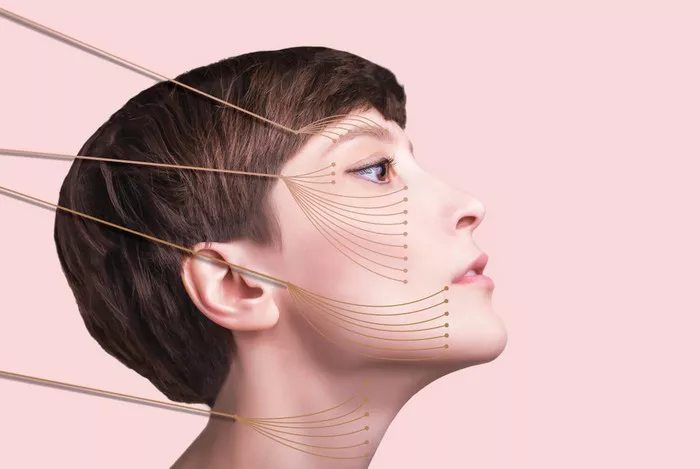As we age, the effects of gravity, loss of collagen, and a decrease in skin elasticity can lead to sagging skin and a tired appearance. Many people seek cosmetic treatments to combat these signs of aging and rejuvenate their facial appearance. One such procedure that has gained popularity in recent years is the thread facelift. In this article, we will explore what a thread facelift entails, how it works, its benefits, and potential risks.
Understanding the Thread Facelift Procedure
A thread facelift, also known as a thread lift or thread rejuvenation, is a non-surgical cosmetic procedure designed to lift and tighten the skin of the face. It involves the use of biodegradable sutures, typically made of polydioxanone (PDO), which are inserted into the skin using a fine needle. These sutures have tiny barbs or cones along their length, which anchor them to the underlying tissues.
During the procedure, a qualified healthcare professional will strategically insert the threads into specific areas of the face, depending on the patient’s desired outcome. The threads create a support structure that lifts the sagging skin, resulting in a more youthful and rejuvenated appearance.
How Does a Thread Facelift Work?
The primary mechanism behind a thread facelift is two-fold: immediate lifting and gradual collagen stimulation. The threads provide an immediate lift to the skin by repositioning and tightening the tissues. The barbs or cones on the threads hold the skin in the lifted position.
Furthermore, the presence of the threads stimulates collagen production in the treated areas. Collagen is a protein responsible for maintaining the skin’s firmness and elasticity. By promoting collagen synthesis, the threads help to improve skin quality and further enhance the results over time.
Benefits of a Thread Facelift
-
Non-surgical
One of the main advantages of a thread facelift is that it is a non-surgical procedure. Unlike traditional facelift surgery, which involves incisions and a more extensive recovery period, a thread facelift can be performed with minimal downtime. This makes it an attractive option for individuals seeking a more youthful appearance without the risks and recovery associated with surgery.
-
Natural-looking results
A thread facelift can provide natural-looking results. The threads lift and reposition the skin without drastic changes or alterations to the facial features. The gradual collagen stimulation also helps to improve skin texture, resulting in a more youthful glow.
-
Customizable treatment
The placement and number of threads used during a thread facelift can be tailored to each individual’s unique needs. This allows the healthcare professional to address specific areas of concern, such as sagging jowls, nasolabial folds, or brow ptosis. The treatment can be personalized to achieve the desired outcome for each patient.
-
Minimal scarring and side effects
Since thread facelifts are minimally invasive, the procedure typically involves minimal scarring. The insertion points for the threads are small and discreet, and any resulting scars are usually barely noticeable. Additionally, side effects such as bruising, swelling, or discomfort are generally mild and resolve within a few days.
-
Quick procedure with minimal downtime
A thread facelift is usually performed as an outpatient procedure and can often be completed within one to two hours. The recovery time is relatively short, with most individuals being able to resume their normal activities shortly after the procedure. This convenience makes it an appealing option for those with busy lifestyles.
Potential Risks and Considerations
While a thread facelift is generally safe, it is essential to be aware of potential risks and considerations before undergoing the procedure. Some possible risks include:
- Infection: There is a slight risk of infection at the insertion sites. However, healthcare professionals take appropriate measures to minimize this risk, such as ensuring a sterile environment during the procedure and prescribing antibiotics if necessary.
- Thread migration or extrusion: In rare cases, the threads may migrate or become visible beneath the skin. If this occurs, additional treatment may be required to address the issue.
- Allergic reactions: Although rare, some individuals may experience allergic reactions to the materials used in the threads. It is crucial to inform the healthcare professional about any known allergies before the procedure.
- Temporary side effects: Temporary side effects such as bruising, swelling, or mild discomfort are common after a thread facelift. These usually resolve within a few days to a week.
- Results may vary: The effectiveness of a thread facelift can vary depending on factors such as individual skin quality, age, and lifestyle. While the procedure can provide noticeable improvements, it may not achieve the same level of results as a surgical facelift.
Conclusion
A thread facelift offers a non-surgical alternative for individuals seeking facial rejuvenation and a more youthful appearance. With its customizable nature, minimal downtime, and natural-looking results, it has become an increasingly popular option in the field of cosmetic medicine. However, it is essential to consult with a qualified healthcare professional to determine if a thread facelift is suitable for your specific needs and to understand the potential risks and benefits associated with the procedure.


